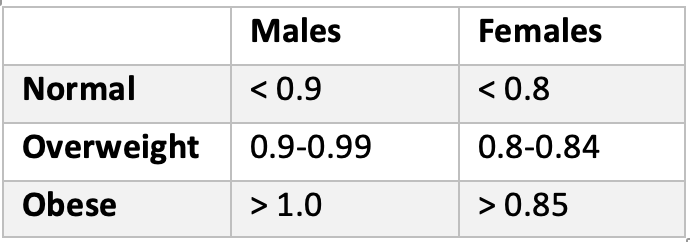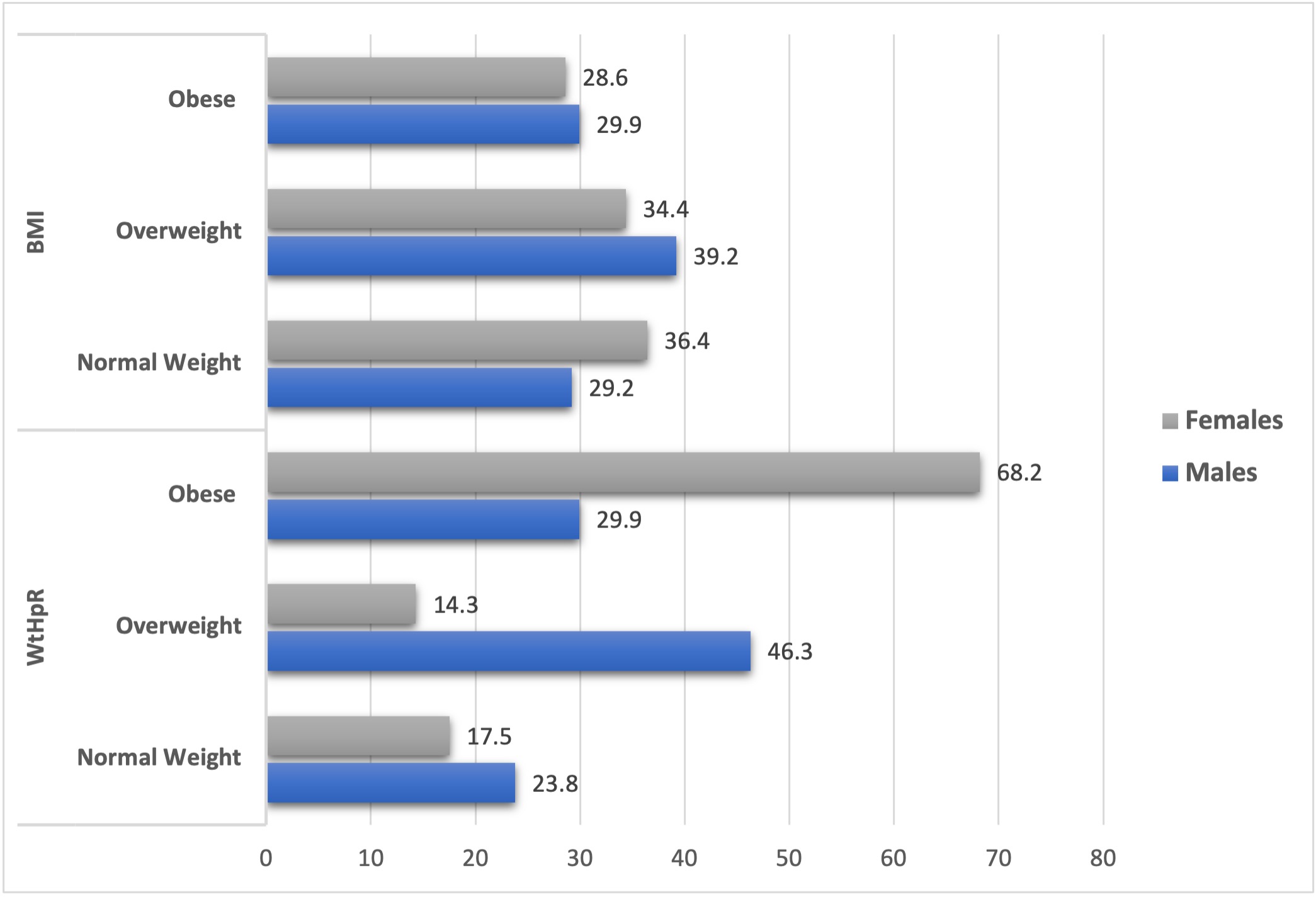Session Information
Date: Monday, November 8, 2021
Session Type: Poster Session C
Session Time: 8:30AM-10:30AM
Background/Purpose: Worldwide prevalence of obesity has been steadily increasing, despite public health campaigns to raise awareness. In axial spondyloarthropathy (axSpA) obesity has been shown to be associated with higher levels of disease activity and decreased response to treatment. The waist to hip ratio (WtHpR) is a tool to screen for abdominal obesity. Abdominal deposition of adipose tissue is associated with increased risk of cardiovascular disease, type II diabetes and premature death. Abdominal obesity is more common in males, with females more prone to gluteal-femoral fat deposition. The Ankylosing Spondylitis Registry of Ireland (ASRI) is a source of epidemiological data of axSpA patients in Ireland. The aim of this study was to capture the prevalence of abdominal obesity in a large cohort of axSpA patients and assess for variation in prevalence between sexes.
Methods: Participants were analysed on the basis of gender and presence of obesity by BMI and WtHpR. Obesity was defined by body mass index (BMI) with a result of >30 categorised as obese as per CDC definitions. Abdominal obesity was assessed by WtHpR and defined as per WHO guidelines (table 1). Categorical variables were tested for statistical significance with a chi2 test for independence, while continuous variables were tested with an independent t-test or Mann Whitney U test. A Spearman’s correlation analysis was run to assess the strength of association between BMI and WtHpR. A p-value of < 0.05 was deemed significant. IBM SPSS version 26 was used for statistical analysis.
Results: At the time of analysis, physical measurements were available on 692 patients in the ASRI made up of 96.2% (666) Caucasians with 22.3% (154) females and 77.7% (538) males. The average age was 45.9 years with a mean disease duration of 18.8 years (mean scores: BASDAI 4.09, BASFI 3.71, BASMI 3.99, HAQ 0.54, ASQoL 6.72). 80.9% (560) of patients had radiographic sacroiliitis while 49.1% (340) had sacroiliitis on MRI.
Overall 29.5% (215) patients were obese based on BMI results, while 37.5% (274) were centrally obese as per the WtHpR. Analysis on the basis of sex revealed no significant variation in mean BMI (28.1 vs 27.7, p=0.45) or prevalence of obesity as assessed by BMI (29.9% vs 28.6%, p=0.49) between males and females (table 2). As expected, analysis of WtHpR revealed higher mean ratios in males compared to females (0.96 vs 0.89, p< 0.01), however there was a significantly higher prevalence of abdominal obesity in females (29.9% vs 68.2%, p< 0.01) (figure 1).
A moderate positive correlation was detected between BMI and WtHpR (rs =0.454, p< 0.01). When cases were analysed within each sex the correlation was noted to be stronger in males than females (rs = 0.543 vs 0.304, p< 0.01).
Conclusion: There is a high prevalence of abdominal obesity as assessed by WtHpR in axSpA, especially in females with axSpA. BMI can underestimate obesity in axSpA women, as the association between BMI and WtHpR is stronger in axSpA males. Use of WtHpR should be considered when screening for obesity in axSpA.
 Table 1: Waist to Height Ratio definitions for Abdominal Obesity as per the World Health Organisation (WHO) guidelines
Table 1: Waist to Height Ratio definitions for Abdominal Obesity as per the World Health Organisation (WHO) guidelines
 Table 2: Assessment of Obesity by Sex
Table 2: Assessment of Obesity by Sex
 Figure 1: Prevalence of Obesity (%) in AxSpA as detected by Body Mass Index (BMI) and Waist to Hip Ratio (WtHpR) within each sex
Figure 1: Prevalence of Obesity (%) in AxSpA as detected by Body Mass Index (BMI) and Waist to Hip Ratio (WtHpR) within each sex
To cite this abstract in AMA style:
Maguire S, Fiona W, Gallagher P, O'Shea F. Body Mass Index (BMI) Underestimates Obesity in Females with Axial Spondyloarthropathy [abstract]. Arthritis Rheumatol. 2021; 73 (suppl 9). https://acrabstracts.org/abstract/body-mass-index-bmi-underestimates-obesity-in-females-with-axial-spondyloarthropathy/. Accessed .« Back to ACR Convergence 2021
ACR Meeting Abstracts - https://acrabstracts.org/abstract/body-mass-index-bmi-underestimates-obesity-in-females-with-axial-spondyloarthropathy/
